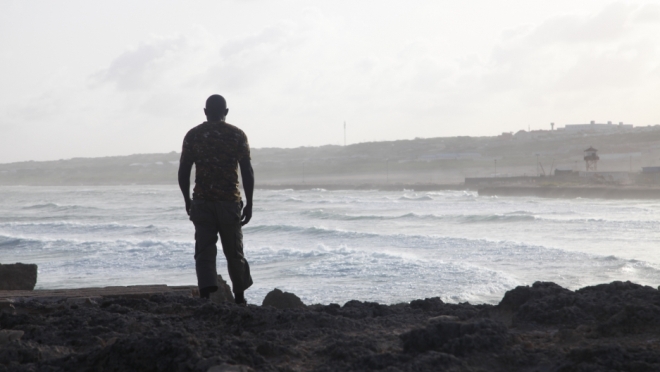In May, Navy SEAL Kyle Milliken was killed in a raid on a terrorist compound in Somalia. He was the first US service member to die in combat in the Horn of Africa nation since the infamous Black Hawk Down incident in 1993, when 18 Americans were killed.
That disaster played a significant role in minimizing US involvement in Africa in the years that followed, affecting then-President Bill Clinton’s decision not to intervene in the Rwandan genocide. But the rise of Somalia-based terror group al-Shabab in the late 2000s has made the Horn of Africa an important front in the war on terror, and US forces are very much a presence in Somalia once again. This time, though, to look around, you wouldn’t really know it.
Decades of war have pummelled the once-stunning capital city of Mogadishu, where despite a new government and relative stability, periodic hit-and-run attacks by al-Shabab keep residents on edge.
But all that is “outside the wire,” as they say at Mogadishu International Airport, a fortified, sprawling base that is home to the African Union Mission in Somalia (AMISOM), various United Nations agencies, and assorted military forces from around the world. With its scorching, sandy backdrop and rough and tumble cast of characters — a mix of grizzled British military guys, UN personnel and journalists — it feels a bit like the cantina scene in the original Star Wars.
But conspicuously missing are Americans.
In May, VICE News published a US Africa Command memo that described involvement in as many as 98 operations a day in Africa, calling it America’s “shadow war.” It’s a good description of US clandestine activities in the region — according to AFRICOM media relations officer Capt. Jennifer Dyrcz, the US mission in the region mainly consists of training and advising partners in AMISOM and the Somali National Army, and she clarified that the “98 operations a day” includes things like routine meetings and assessments.
“Due to the location of some of our advisory and training activities, SOCAFRICA’s personnel are occasionally exposed to some of the same risks as our partners and defend themselves appropriately,” she added.
Maj. Ali Dhuuh Santur Guled of the Somali National Army is responsible for training, and in this capacity, he has worked a great deal with US special forces. He says it’s largely due to US assistance that his army has dealt some major blows to al-Shabab in the last few years.
“They used to live around the presidential palace, just firing bullets,” he said. “But now they are all retreated from the city, and they live in some districts in remote areas. So they are totally weak. And nowadays they sometimes try to make guerrilla attacks, but they are really weak, compared to the past years.”
In March of this year, US President Donald Trump gave the Pentagon more authority to carry out airstrikes and raids in Somalia and in April he deployed a few dozen troops from the 101st Airborne Division on a train-and-equip mission. US special forces are now helping to train Somali soldiers at a new base called Baledogle, some 50 miles from Mogadishu, deep in al-Shabab country.
But as appreciative as the Somali army is of US assistance, Santur says they need more.
“We were expecting that when Trump came to power that he would fight against terrorist activities very powerfully,” he said. “We are still waiting.”
He calls Americans and Somalis brothers and sisters, noting that the new president of Somalia, Mohamed Abdullahi Mohamed, elected earlier this year, is an American citizen from Buffalo, New York. He is hopeful that President Trump will give them what they need. What they need, he says, is tanks and other heavy weaponry to bring a speedy end to the drawn-out conflict.
For that to happen, the arms embargo that has been in place since 1992 would need to be lifted. Somali President Mohamed Abdullah Mohamed, pleaded with the international community at a summit held in London in May to do just that.
“Al-Shabab has AK-47s and the Somali National Army has the same equipment, the same weapons. And that’s why this war has been lingering for 10 years,” he said. “If we don’t have more sophisticated and better weaponry, this war will definitely continue for another 10 years.”
The stakes for ending the conflict are high, and not only due to the ongoing attacks. The continued presence of Al Shabaab militants in remote areas of Somalia is complicating relief efforts amid a drought that is causing the worst food insecurity to hit the country since a quarter of a million people died in the famine of 2011-2012.
![]()






























